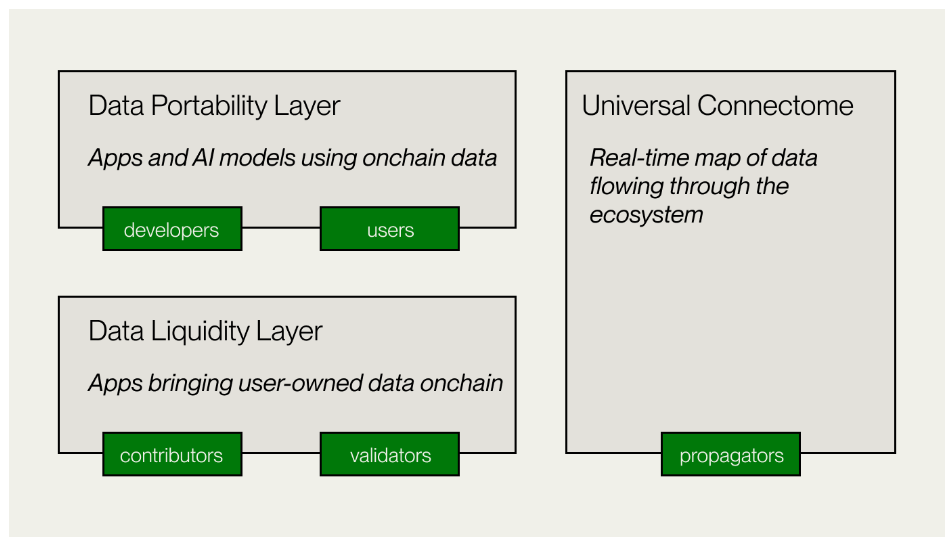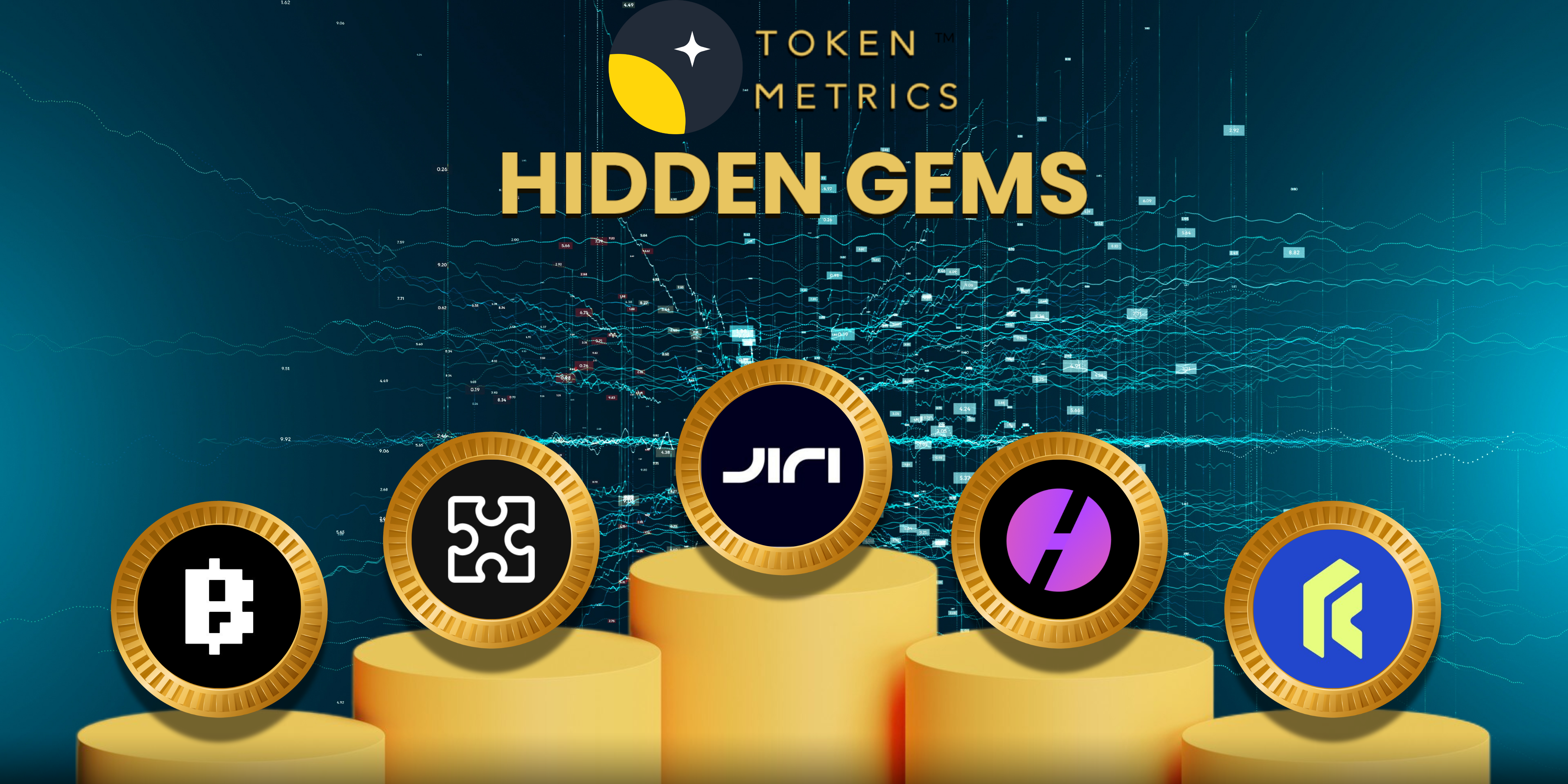Executive Summary
Vana is a decentralized platform that enables individuals to reclaim ownership of their data and make it portable across various applications. Built on a distributed, decentralized network, Vana prioritizes private, user-owned data, empowering users to control, manage, and monetize AI models trained on their data. Developers benefit from access to cross-platform data, which can be used to create personalized applications and train advanced AI models. At its core, Vana functions as a data liquidity network, addressing the “double spend” problem for data. This innovation treats data as a flexible, modular financial asset. Vana fosters a data-driven economy owned by its participants rather than centralized entities by aligning incentives among data owners, developers, and consumers.
Vana comprises two essential layers: the Data Liquidity Layer, which introduces data on-chain as transferable digital assets, and the Application Layer, or Data Portability Layer, which supports user-owned applications powered by verified data. The platform’s universal connectome provides a permissionless, real-time map of data flows throughout the ecosystem.
About the Project
Vision
To empower users with full control over their data by establishing a distributed network for private, user-owned information that facilitates user-driven AI. The goal is to evolve into an EVM-compatible Layer 1 blockchain with native support for private data.
Problem
Companies such as Reddit, Alphabet (Google), Amazon, and Meta (Facebook) have expanded to the point where they now dominate the information and communication technology sector. As a result, a significant amount of user data is stored and controlled by these corporations, often without users being fully aware or having any meaningful control over their personal information. AI systems are fundamentally built on large datasets and advanced algorithms that learn iteratively by identifying patterns and extracting features from the data. Each time the system processes data, it evaluates its performance, refining its understanding and improving its accuracy. This process continues until the system achieves predefined success criteria, allowing it to be deployed effectively.
The link between data and AI is clear and crucial. High-quality data is essential for shaping AI systems into reliable interpreters capable of navigating complex datasets and deriving valuable insights. It is not merely the quantity of data that matters but its quality, diversity, and relevance which fuel the continuous improvement and evolution of AI technologies. As AI advances, the demand for accessible, high-quality data becomes even more pronounced, highlighting the importance of data governance and user control in an increasingly data-driven world. The excessive concentration of power over data and AI presents significant risks.
Solution
Vana represents the first network for user-owned data, introducing a new paradigm: an open internet where users own and govern their data and its intelligent products. This model allows users to earn a stake in the AI models they contribute, ensuring that value flows directly to them and to independent model developers, rather than to centralized platforms. At its core, Vana serves as the user-owned infrastructure for a data-driven economy, controlled by its participants rather than by centralized entities.
Vana is designed to be radically inclusive, welcoming contributions of data, computing power, and ideas from anyone, regardless of geography, credentials, or financial resources. Participants can own a share of the system, democratizing access and opportunity. Open-source researchers gain access to superior computing and data resources, surpassing those available to leading centralized AI companies today. Vana aims to build the world’s most immense user-owned data treasury — a valuable resource for constructing the most advanced AI models. In the long term, it is expected that even major tech companies may seek access to data on Vana to push the boundaries of AI development.
How does it work?

Vana operates as a decentralized network that facilitates global data creation and promotes advancements in artificial intelligence (AI) within an open data economy. The network comprises two primary layers: the Data Liquidity Layer and the Data Portability Layer, which support user-owned data applications powered by verified data. The universal connectome serves as a permissionless, real-time map of data transactions within the ecosystem.
Data Liquidity Layer
The Data Liquidity Layer is the foundation where data is contributed, validated, and recorded into Data Liquidity Pools (DLPs). In this layer, creators establish DLP smart contracts that outline specific objectives for data contributions, including the purpose of the DLP, validation methods, and contribution parameters.
Data contributors and custodians submit their data to DLPs for validation and earn governance rights and rewards based on the parameters defined in the DLP validation process. The primary function of the Data Liquidity Layer is to facilitate on-chain data transactions among data contributors, custodians, and DLP validators, ensuring organized data collection and management for both users and developers throughout the ecosystem.
Data Portability Layer
The Data Portability Layer, also called the Application Layer, is an open platform for collaboration between data contributors and developers. It leverages the data liquidity accumulated in DLPs to support the distributed training of user-owned foundational models and the development of innovative AI decentralized applications (dApps). This layer acts as a dynamic data hub, allowing online communities to collaborate with developers to generate real economic value from their data. It fosters an interactive ecosystem where data contributors can benefit from the network effects and value generated from the intelligence derived from their contributions.
Connectome
The Connectome is a decentralized ledger that records real-time data transactions across Vana’s ecosystem. Utilizing a proof-of-stake consensus mechanism, Connectome propagators ensure the validity of DLP token transfers and enable cross-DLP data access for user-owned data applications. The Connectome provides transparency by allowing external parties to monitor data transactions throughout the network. Furthermore, its compatibility with Ethereum Virtual Machine (EVM) enhances interoperability with other EVM networks, protocols, and decentralized finance (DeFi) applications.
Market Analysis
The global artificial intelligence (AI) market was valued at approximately USD 196.63 billion in 2023 and is projected to expand at a compound annual growth rate (CAGR) of 36.6% from 2024 to 2030. This growth is primarily driven by ongoing research and innovation from major technology companies, facilitating the adoption of advanced technologies across various industries. In 2023, funding for AI-related web3 projects surged to USD 298 million, surpassing the total budget of USD 148.5 million raised for AI projects from 2016 to 2022. The performance of AI-related tokens has also been notable, with the top five AI cryptocurrencies by market capitalization significantly outperforming Bitcoin (BTC) and Ethereum (ETH), achieving gains ranging from 200% to 650% throughout the year. Several trends and practical applications have emerged from the intersection of AI and cryptocurrency, indicating a rapid increase in AI adoption. The future landscape appears increasingly dominated by AI technologies, reflecting a robust trajectory of growth and innovation in this sector.
Competitors – Currently, there are no direct competitors to Vana in the decentralized AI space. While there are protocols focused on data collection, none have specifically targeted social media data in the same manner as Vana.
Unique Value proposition
With Vana, users maintain complete control over their valuable data through a non-custodial model. Individuals can now contribute to the network by exporting their data from various platforms, leveraging data rights to circumvent the walled gardens of large technology companies. Vana’s proof-of-contribution mechanism ensures data quality by rewarding users proportionally to their data’s impact on AI model performance. Once reclaimed, users can analyze their data to discover valuable insights and utilize them in a wide range of novel AI-powered applications. Users can even form data collectives and sell their data directly.
Vana operates as a user-owned infrastructure for a data-driven economy governed by its participants rather than centralized authorities. Anyone can create Data Liquidity Pools (DLPs) with their data, and Vana provides incentives for making such pools. Individuals can easily access these pools and contribute their data in a completely private and secure manner. By empowering users to own their data and the value it generates, Vana fosters a robust ecosystem where communities can collaboratively train models on their data while preserving privacy.
The most distinctive aspect of Vana is its focus on collecting private data from social media, a feat that no other project has successfully achieved. Vana is actively pursuing this initiative and has gained significant traction. By enabling users to reclaim their social media data, Vana empowers individuals to utilize their information in previously unavailable ways. This innovative approach enhances user control over personal data and facilitates the development of AI models informed by authentic user experiences. As a result, Vana is positioned to lead in user-owned data, setting itself apart from competitors in the market. The platform’s commitment to data privacy and user governance further underscores its unique value proposition. It allows users to manage their data securely while participating in a decentralized data economy.
Features
- Layer One Blockchain: Vana is a blockchain specifically designed to manage private, user-owned data, thereby facilitating a decentralized data economy. At its core, Vana functions as a data liquidity network, effectively addressing the double-spend problem associated with data and enabling data to be liquid and transferable.
- User-Owned Data Treasury: This system allows users to collectively own and govern their data, ensuring they benefit from the value generated by AI models trained on their contributions.
- User-Owned Foundation Models: Vana enables users to train and own foundational AI models collaboratively, decentralizing control away from centralized entities and promoting a more equitable power distribution.
- Data Liquidity Pools (DLPs): Vana’s framework incentivizes and validates data contributions, making them accessible for AI training while maintaining user privacy. These pools facilitate a secure environment for data contributors, ensuring their contributions are valued and utilized effectively within the ecosystem.
- Proof of Contribution: Vana employs a Proof-of-Contribution (PoC) system to validate the data submitted to its network, ensuring the integrity and quality of data within its Data Liquidity Pools (DLPs). Given that each user’s data is unique, the PoC system facilitates data liquidity by mapping this data to a fungible asset, enabling efficient exchange and utilization within the ecosystem.
Token
The VANA ecosystem consists of two primary types of tokens: $VANA and DLP tokens.
$VANA
$VANA is the native token of the Vana Network and serves multiple purposes within the ecosystem. It is used to pay for transaction fees, commonly referred to as gas fees, on the Vana Network. Another critical aspect of $VANA is its governance functionality. Token holders are granted governance rights, allowing them to participate in essential network decisions, including voting on matters such as allocating grants to the Vana Foundation and adding or removing Data Liquidity Pools (DLPs).
DLP Token
In addition to $VANA, each Data Liquidity Pool (DLP) on the Vana platform can deploy its own ERC-20 compatible token, defined by the DLP creator. These DLP tokens serve two primary functions. First, they reward individuals who contribute their personal data to the pool, incentivizing participation and engagement. Second, DLP token holders are granted governance rights within their respective pools, allowing them to participate in decision-making processes affecting the pool’s operations.
By incorporating these two types of tokens, the VANA ecosystem aims to incentivize data contributions, ensure fair governance, and promote the growth of a decentralized data economy. This structure empowers users and fosters a collaborative environment where data ownership and value generation are prioritized.
Traction
The Reddit DAO has been active for several months and has gained significant traction, with 140,000 users joining. Users can connect their Reddit accounts, contribute data, and start earning rewards.
Other active DAOs in the Vana network include Volara and Finquarium. Volara is recognized as the leading Twitter/X Data Liquidity Pool (DLP) on the Vana network, while Finquarium serves as a premier Financial Forecasting DataDAO within the ecosystem. Finquarium empowers financial experts to share high-quality predictions and promotes transparency and accountability through performance tracking. Both Volara and Finquarium are currently in a pre-mining phase, welcoming early adopters to participate. With a growing community and a range of innovative DAOs, Vana is positioning itself as a leader in the decentralized data economy, fostering a more open, inclusive, and user-driven digital landscape.
Investors
Vana is supported by prominent investors, including Paradigm and Polychain and have a raised a total $20M in funding.
Team
Anna Kazlauskas and Art Abal co-founded Vana in 2021. Before starting Vana, Anna studied computer science and economics at MIT and went on to launch Iambiq, a fintech automation startup, through Y Combinator. She also gained experience as a member of the engineering team at Celo. Art Abal, a corporate lawyer by training, previously worked as an associate at The Cadmus Group, a consulting firm based in Boston. He later led impact sourcing at Appen, a data annotation company.
Together, Kazlauskas and Abal combined their diverse experiences in technology, law, and impact-driven projects to shape Vana’s mission of empowering individuals with control over their data.
Conclusion
Vana is a decentralized platform that enables individuals to reclaim ownership of their data and make it portable across various applications, addressing a critical challenge in the rapidly evolving AI landscape. Vana leverages decentralized markets and incentive structures to bring together data and achieve shared objectives. Vana introduces a model of open ownership and governance over the critical technological systems that will shape our future. It is not merely an infrastructure for developing AI in a new way but also the foundation for a new kind of digital economy—one that is inherently open, collaborative, and empowering, where the value generated from data and AI benefits many rather than a select few. To date, Vana has achieved impressive adoption rates, underscoring the strength and potential of the project as a significant player in the decentralized data ecosystem.
| Fundamental Analysis | |||||
| Assessment | |||||
| Problem | Significant, long-term problem | 3 | |||
| Solution | Distinct, defensible solution | 3 | |||
| Market Size | Large market, significant growth potential | 3 | |||
| Competitors | Emerging market with few strong competitors | 3 | |||
| Unique Value Proposition | Clear differentiation and value for customers | 3 | |||
| Current Traction | Early traction, user engagement starting to grow | 2 | |||
| Unit Economics | Unit economics currently negative, no clear path to profitability | 1 | |||
| Tokenomics | Basic token strategy, potential for improvement | 2 | |||
| Product Roadmap | Basic roadmap, lacks detail or innovative features | 2 | |||
| Business Model | Proven business model with clear path to profitability | 3 | |||
| Go-to-Market Strategy | Basic GTM strategy, lacks detail or differentiation | 2 | |||
| Regulatory Risks | Minimal regulatory risk, strong mitigation and adaptability | 4 | |||
| Total | 64.58% | ||||





